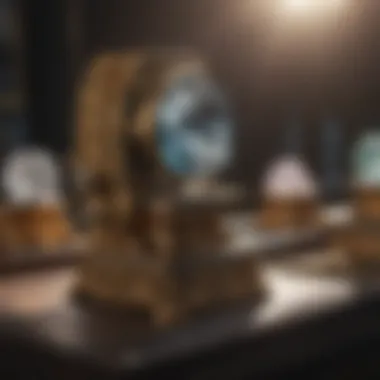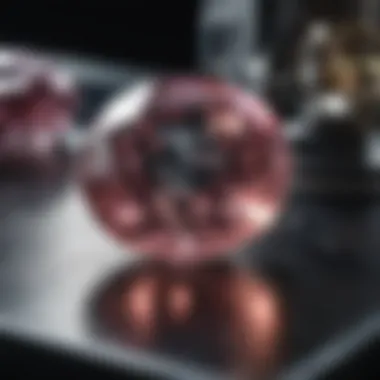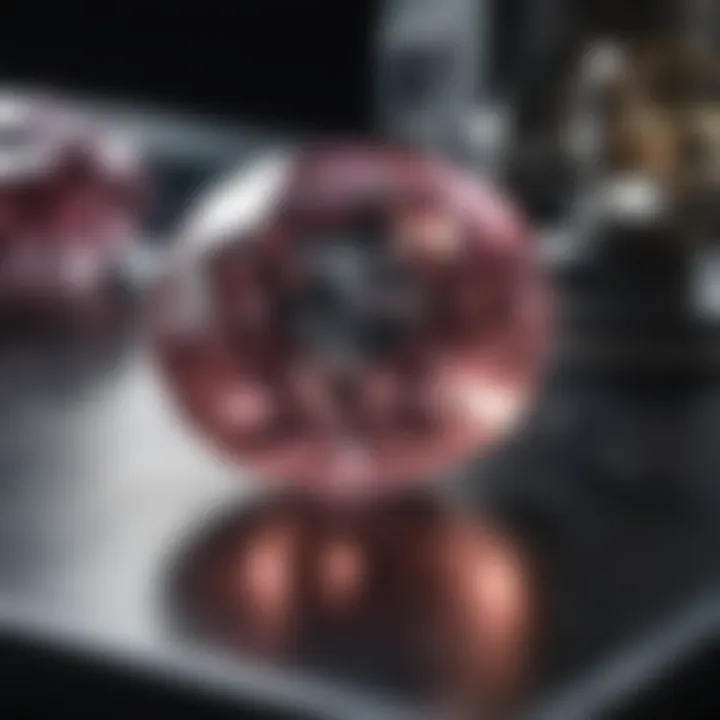A Deep Dive into Gemstone Faceting Machines


Intro
The gem-cutting craft is an intricate dance of precision and artistry, made possible by the remarkable innovations in gemstone faceting machines. These devices stand as pivotal tools that not only cut the stone but also play an instrumental role in realizing its full potential. As we peel back the layers of this field, we will illuminate the evolution of these machines, their various forms, and the technology embedded in their operations.
In a world where a diamond’s sparkle can ignite desires and colored gemstones can evoke emotions, understanding the mechanisms behind faceting provides insights far beyond surface-level appreciation. This exploration seeks to dissect the components that enhance not just the aesthetics of gemstones but also their intrinsic value. From the selection process of a faceting machine to the emerging trends transforming gemology, this article offers a compass for both enthusiasts and professionals navigating the vast ocean of gemstones.
In the subsequent sections, we will embark on a journey through different facets of gemstone faceting machines, starting with a foundational understanding of gemstones themselves.
Intro to Gemstone Faceting
Gemstone faceting is a specialized art, crucial for transforming rough stones into dazzling gems. This section will shed light on what faceting entails, why it holds significance in gemology, and how its historical context shapes our understanding today.
Definition of Faceting
Faceting refers to the process of cutting a gemstone into multiple flat surfaces called facets. These facets are crafted in such a way that they enhance the stone's color and brilliance, allowing it to reflect light magnificently. Simply put, cutting a gem is about shaping its journey from raw mineral to refined beauty. Each facet acts as a tiny mirror, catching and reflecting light, that brings a seemingly lifeless stone to vibrant life. The angles and sizes of these facets are essential; they determine how the stone will gather and transmit light.
Importance in Gemology
In the realm of gemology, faceting isn’t merely a technical skill; it’s an essential element that influences a stone’s value and desirability. A well-faceted stone exhibits more sparkle than a poorly cut one. This directly correlates to how the gem interacts with light, enhancing its visual appeal. Higher-quality facets mean a greater price point in the market. Moreover, gem enthusiasts and collectors often seek original cuts that distinguish their gems from mass-produced alternatives. It elevates the status of the stone in both aesthetic and monetary value.
Historical Background
The journey of faceting can be traced back centuries. In ancient times, gems were often polished rather than cut. The idea of faceting a stone likely emerged alongside the rise of gemology, evolving through observations of light and stone properties. Historical records reveal that the first known faceted stones appeared during the Renaissance, signaling a major shift in how gemstones were perceived and utilized. Jewelers began experimenting with various cuts, leading to the innovative techniques seen today. This has paved the way for major designs like the round brilliant cut, which continues to be a favorite among jewelers and collectors alike.
Understanding the history of gemstone faceting provides context for both the craft and the evolution of gemology. Techniques may have changed, but the core principle of enhancing beauty remains constant.
Types of Faceting Machines
Understanding the various types of faceting machines is crucial for anyone invested in the art of gemstone cutting. Each type offers distinct advantages and addresses different levels of expertise, comfort, and technologic integration. This section outlines the different kinds of faceting machines and their significance in gemology, providing insights that assist enthusiasts, collectors, and jewelry designers alike in making informed decisions regarding their tools.
Manual Faceting Machines
Manual faceting machines are often the preference for traditionalists. These machines require the operator to have a strong skill set, as the art of faceting involves a significant amount of precision and craftsmanship. An operator using a manual machine relies heavily on their tactile skills and experience to shape and polish a stone.
The main features of manual faceting machines can include:
- Physical Control: The operator not only has control over the speed and angle of the facets they are cutting but also learns through the practice of trial and error.
- Cost Efficiency: Generally, these machines are more budget-friendly when compared to their automated counterparts, making them suitable for hobbyists or those starting their journey in gem cutting.
- Skill Development: Using manual machines helps cutlers refine their skills, allowing them to develop a deeper understanding of how different stones react to various cutting techniques.
However, there are trade-offs - the manual process can be time-consuming and requires significant patience. The learning curve is often steep, but those who master it find a profound satisfaction in creating beautiful gemstones by hand.
Automatic Faceting Machines
Automatic faceting machines bring a different tone to the gem-cutting process. These machines incorporate motorized functions that streamline the faceting process, drastically reducing the time it takes to cut gemstones. For many professionals, the increased efficiency is a significant draw.
Highlights of automatic faceting machines include:
- Time-Saving: With the ability to program precise angles and cutting paths, gem-cutters can produce a more extensive selection of cuts in a fraction of the time.
- Consistent Quality: Automatic machines often guarantee a higher level of precision, leading to consistent quality across multiple stones.
While they still require some skill, the learning curve is not as steep as with manual machines. They are especially advantageous in a commercial setting where output needs to be maximized. On the downside, the initial investment can be considerable.
Computerized Faceting Machines
Computerized faceting machines take technology to a new level. They often include sophisticated software that can simulate the cutting process before any material is touched. The integration of artificial intelligence allows for adjustments and optimizations that would be challenging to achieve manually.
Key advantages of computerized faceting machines are:
- Precision Mapping: These machines can plot complex designs and cuts with extraordinary accuracy, making them well-suited for intricate designs and higher-quality gemstones.
- User-Friendly Interfaces: With touchscreen controls and straightforward programming, even those new to the field can quickly grasp how to operate these machines.
Nevertheless, with sophistication comes costs. They represent the high end of the market and often necessitate understanding both the machine and the software. Knowledge of computer-aided design can be a valuable asset in fully utilizing their capabilities.
"Understanding the differences between manual, automatic, and computerized faceting machines can drastically impact your approach to gemstone cutting."
In sum, whether one chooses a manual, automatic, or computerized method depends on factors such as budget, personal skill level, and the intended purpose of the gemstones being cut. Each type of faceting machine contributes to the rich tapestry of gemology and the art of gem cutting, making it essential for enthusiasts to understand their options thoroughly.
Mechanics of Faceting Machines


Understanding the mechanics of faceting machines is crucial for anyone wanting to delve into the gemstone cutting world. The interplay between technology and artistry in this domain is not just fascinating; it is foundational. Faceting machines—whether manual or automated—transform raw stones into dazzling gems. This transformation relies on precise mechanical components that ensure accuracy and effectiveness in cutting gems. Their mechanics dictate the quality of the finished product, making it essential for craftsmen to have a solid grasp of these machines' inner workings.
Basic Components
The complexity of a faceting machine boils down to several key components. Each one plays a vital role in achieving the desired outcome in gem cutting. It is only by understanding these elements that one can appreciate the precision involved in this craft.
Motor and Control Mechanisms
The motor and control mechanisms are the heart of any faceting machine. They provide the power needed to rotate the gem and the grinding wheel. A high-quality motor ensures a consistent speed, which is critical. Variability in speed can lead to uneven cuts. For example, machines equipped with stepper motors can offer greater control over speed and precision, making them a popular choice among hobbyists and professionals alike.
Unique Feature:
These motors often come with programmable controls, allowing users to set specific parameters for various cuts, which adds a layer of convenience and customization. However, reliance on technology can sometimes lead to over-engineering, which might scare off beginners who prefer something simpler.
Grinding Wheels and Tools
Grinding wheels are fundamental to the faceting process. Without these specialized tools, achieving the correct angles and symmetry would be impossible. The composition of the grinding wheel varies—diamond wheels, for instance, enable sharper and more precise cuts thanks to their hardness.
Key Characteristic:
The choice of grit size on the wheel has a significant impact on the finish of the gem. Finer grits are used for polishing after the basic shape has been established. While they enhance the gleam of the stone, the process requires skill to avoid damaging the facets during polishing. Some newcomers find it daunting, but with practice, one can master the subtleties between wheel types and their applications.
Laser and Optical Systems
Laser and optical systems are becoming increasingly relevant in modern faceting machines. They assist in determining the exact angles for cuts with remarkable precision. These systems provide instant feedback, which is essential for adjusting cuts on the fly, a feature that traditional methods lack.
Key Feature:
The integration of laser technology has drastically improved efficiency and accuracy in faceting. However, incorporating these systems often comes at a higher initial cost, making them less accessible for beginners or those on a tight budget.
Operating Principles
At the core of any faceting machine lies the operating principles that dictate how all these components work harmoniously together. Understanding these principles is not merely an academic exercise; it is essential for anyone looking to create beautifully faceted gemstones. The interplay between rotating elements, grinding pressures, and angle adjustments ensures that even the most intricate designs can be achieved with precision.
Selection Criteria for Faceting Machines
Choosing the right faceting machine is a pivotal step for anyone who desires to delve into the world of gem cutting. This process is anything but trivial, as the efficiency and quality of your workmanship largely hinge on this choice. With machines available at various price points and functionalities, understanding the selection criteria is essential for both novices and seasoned gem cutters alike. Factors such as skill level, budget, and the types of gemstones you plan to work with play significant roles in narrowing down your options.
Skill Level Considerations
When it comes to skill level, the range varies widely between hobbyists and professionals. For beginners, a user-friendly manual faceting machine can offer essential hands-on experience without overwhelming complexity. These machines often feature simpler controls, allowing newcomers to grasp the basics of faceting, like adjusting angles and polishing techniques.
In contrast, those with more advanced skills may lean towards automatic or computerized models that allow for precision and efficiency. This is where the nuance really begins—machines designed for experienced users might come equipped with advanced programming capabilities that enable precise cuts and custom settings.
"The right tool can make or break a gem cutter’s career. Always choose a machine that complements your current skill set while introducing you to new techniques."
Budget Constraints
Budget is undoubtedly one of the most determinative aspects of your selection process. Faceting machines span a wide price range, from a few hundred dollars for basic units to several thousand for sophisticated computerized systems.
It's important to remember that spending money on quality from the start can significantly affect the quality of your final products. However, not every bottom line has to ensure you purchase the latest and greatest on the market. A well-functioning used machine can be a steal for someone on a budget.
Here are aspects to consider concerning your budget:
- Initial Purchase Cost: Factor in the price of the machine itself alongside necessary accessories.
- Long-term Costs: Don’t forget to include maintenance and replacement parts.
- Value of Output: Generally, the more you invest, the better the gems you can produce, potentially leading to higher resale value.
Type of Gemstones Being Cut
The gemstones you intend to work with should also guide your selection. Different materials require different approaches and machines. For softer stones, a less powerful machine suffices, while harder stones necessitate equipment that can withstand increased pressure and heat during the cutting process.
For example:
- Diamonds: Due to their hardness, they’ll require a more robust setup to handle the intricate cuts without damaging the machine.
- Opals: These softer stones require delicate handling. A machine with adjustable speed and gentler touch would be ideal.
- Sapphires and Rubies: These typically call for more versatile machinery capable of deft cuts that bring out their vivid colors.
Understanding your material not only informs what machine you should select, but also shapes your overall cutting strategy and anticipated results. It’s always worth taking time to research specific requirements for different types of gemstones to ensure you choose a machine that matches your vision.
Role in Enhancing Gemstone Aesthetics


Gemstone faceting plays a critical part in maximizing the beauty of gemstones. It’s not just about cutting a stone into a specific shape; it’s about bringing out its intrinsic qualities and elevating its visual appeal. Faceting can dramatically affect how light interacts with the stone, which in turn defines its brilliance, fire, and overall allure.
Faceting Techniques
Understanding different faceting techniques is crucial for one looking to enhance the aesthetics of gemstones. Each method offers its unique flair, caters to specific preferences, and employs various cutting principles.
Brilliant Cut
The Brilliant Cut is the darling among faceting methods due to its remarkable ability to maximize the reflection and refraction of light. Characterized by its numerous facets and symmetrical design, this cut is particularly popular in diamonds and other gemstones that benefit from high light dispersion. The signature elements of a Brilliant Cut are its round shape and typically between 57 to 58 facets, which create a stunning sparkle.
One unique feature of the Brilliant Cut is its carefully calculated angles. This design allows for light to enter the gemstone and bounce within its facets before exiting, producing a spectacular brilliance. However, this cut can also be tricky, as imperfections in the cut can lead to a duller appearance. Yet, when executed correctly, the Brilliant Cut stands as a benchmark of gemstone aesthetics.
Step Cut
The Step Cut, contrasting with the Brilliant Cut’s multitude of angles, boasts fewer facets which create a series of stair-like reflections. This method is typically preferred for gemstones like emeralds and aquamarines, where clarity and color take the forefront over radiance. The key characteristic of the Step Cut is its rectangular or square shape, usually featuring up to 50 facets.
While it may lack some of the sparkle associated with the Brilliant Cut, the Step Cut emphasizes the stone's color depth and clarity beautifully. Unique to this style is how it often reveals "windows" within the gemstone, lending a different kind of visual intrigue. One downside, however, is that these cuts can sometimes make inclusions more visible, which could detract from a gemstone's overall appeal in certain contexts.
Rose Cut
The Rose Cut is an antique style, making a resurgence among modern gemstone enthusiasts. With a distinctive dome shape and a flat back, this cut features asymmetrical facets that create a unique play of light. The key characteristic here is its fashionable vintage appeal, often seen in jewelry design today.
What sets the Rose Cut apart is its ability to produce soft, luminous reflections rather than hard brilliance. This makes it an ideal choice for those who appreciate understated elegance. However, its facets might not be as effective in reflecting light as the Brilliant Cut, which can leave some gemstones appearing less vibrant.
Impact on Light Interaction
The interaction of light with a gemstone largely determines its final appearance. The cut and shape influence how light enters and exits the stone, ultimately defining its brilliance, fire, and scintillation. By mastering these techniques and choosing the right cut, gemologists and designers can enhance the aesthetic qualities of gems to appeal to collectors and enthusiasts alike.
Quality Control in Faceting
Quality control in faceting is a critical component that plays a significant role in ensuring the overall quality and aesthetic value of the finished gemstones. In gemology, the precision of each facet can make or break the visual appeal and market value of a gem. Therefore, understanding how to achieve and maintain high standards of quality is essential for gem cutters and lapidaries.
In the realm of gemstone faceting, quality control encompasses several vital points. First, it establishes benchmarks for evaluating the final product. Second, it ensures consistency in craftsmanship, which is particularly important when producing multiple stones intended to match in style and design. Lastly, a stringent quality control process aids in identifying defects early, allowing for corrective action before the gemstone reaches the market.
> "A stone is only as good as the cut it carries; without quality control, beautiful stones may become mere lumps of potential."
Adopting effective quality control measures can be the difference between a mediocre gemstone and a masterpiece that catches the eye of collectors and enthusiasts alike.
Measuring Precision in Facets
Precision when it comes to facets is non-negotiable. Each angle, each facet must be perfect – quite akin to aligning the stars for a clear night sky. Using tools like protractors, digital calipers, and optical comparators, gem cutters can measure angles and check alignments accurately. This process not only helps in fulfilling the design specifications of the gemstone but also assists in evaluating how effectively the gem can reflect and refract light.
One of the primary metrics to gauge precision is the angle at which facets are cut. Even a slight deviation can result in the gem achieving none of its sparkle potential. Adopting systematic measuring practices ensures that every cut shines bright, lending that extra bit of allure to the finished product.
Common Defects in Faceting
While quality control is all about achieving perfection, there are common defects that arise during faceting. Understanding these issues is essential for improving the faceting process and ensuring high standards.
Saw Marks
Saw marks are one of the most prevalent issues in the faceting process. They occur when the cutting blade leaves visible scratches or grooves on the gemstone's surface. Typically, this happens if the operator applies too much pressure or uses a blade that's not sharp enough. The key characteristic of this defect is its visibility; saw marks can drastically reduce the aesthetic appeal of a stone.
For those interested in quality craftsmanship, removing saw marks is a must, often requiring additional grinding or polishing. While having saw marks might save time, it's rarely a beneficial choice, as it compromises the gemstone's overall look. The unique feature of saw marks is their tendency to catch light unfavorably, creating an uneven appearance that can detract from the gem's beauty.
Uneven Facets
Uneven facets are another concern that can hinder a gemstone’s brilliance. This defect arises when facets are cut at inconsistent angles or uneven depths, often leading to lopsided or asymmetrical shapes. The main takeaway with uneven facets is that they disrupt the internal light dynamics of a gemstone. When light hits uneven facets, it may cause unwanted dark spots or even dullness in certain areas.
While some might argue that flaws can add character, in the gemological context, uneven facets are often seen as a detriment to the gem's value. Proper quality control procedures can help to identify and correct this issue during the cutting process, ensuring that each facet is uniform. The most significant advantage of even facets is that they enhance the gemstone's overall sparkle, bringing out its true potential.
Color Zoning
Color zoning refers to the uneven distribution of color within a gemstone, and it can be a double-edged sword. On one hand, it can create visual intrigue and depth; on the other, it can detract from an otherwise stunning gem. This characteristic is often caused by variations in the crystal structure or impurities during the formation process. Color zoning is particularly relevant in stones like tourmaline and beryl, where such features can either enhance or undermine their value.
When addressing color zoning, the focus should be on how to manage its effect on the overall appearance of the stone. Some techniques in faceting can help minimize the visibility of zoning, preserving the gem's overall allure while achieving the desired artistic effect.
Maintenance and Care


Maintaining and caring for gemstone faceting machines is not just about preserving a tool; it is about ensuring the quality of the gemstones produced. These machines are significant investments, and with proper maintenance, they can work efficiently and yield superior results. Ignoring the care of these intricate devices can lead to poor performance, potential defects in gems, and considerable repair costs over time.
Key benefits of regular maintenance include:
- Enhanced Performance: Machines that are well-maintained tend to function more smoothly, reducing wear and tear on components.
- Precision in Gem Cutting: Regular care helps maintain the accuracy of cuts, which is crucial for achieving the desired aesthetic qualities in gemstones.
- Extended Lifespan: A little effort goes a long way. By routinely checking and cleaning them, the longevity of the machine increases significantly.
- Cost Savings: Consistent maintenance can save a considerable amount of money over time, as it helps to prevent major breakdowns that can be expensive to fix.
Though many may think cleaning and care is an afterthought, it should be considered an ongoing responsibility. The requirements may vary from one machine to another, thus it is important to consult the specific manufacturer's instructions for detailed guidance.
Routine Cleaning Protocols
Regular cleaning is paramount for maintaining the functionality of gemstone faceting machines. Here are some basic protocols to consider:
- Dusting and Wiping: Use a soft cloth to dust off the machine regularly. Be cautious not to scratch any polished surfaces.
- Cleaning Components: The grinding wheels and other exposed parts should be cleaned with appropriate solvents that won't damage them. Avoid harsh chemicals that can create residues detrimental to gem quality.
- Lubrication: Periodic lubrication of moving parts reduces friction, ensuring smooth operations. Always use the recommended lubricant for your specific model.
- Inspections: Frequent inspections for dust accumulation in narrow spaces and parts that experience friction are also a good practice. Early detection can prevent minor issues from growing into significant problems.
"A clean machine is a happy machine. Always prioritize cleanliness to avoid unnecessary troubles down the line."
Replacement of Components
As with any intricate machinery, the components of gemstone faceting machines may wear out over time. Knowing when and how to replace these parts is crucial for effective operation.
Key factors for consideration include:
- Manufacturers’ Guidelines: Check the manufacturer's recommendations for how often parts should typically be replaced based on usage. Some components may need replacement more frequently than others.
- Signs of Wear: Be attentive to signs of wear on grinding wheels, motors, or any control mechanisms. If precision begins to falter, it might be time for replacements.
- Compatibility Issues: When replacing components, ensure that they are compatible with existing parts to avoid operational glitches. Using OEM parts typically guarantees better performance.
- Professional Assistance: For major component replacements, it could be beneficial to consult with a professional. This may save you from potential misalignments or poor installation.
With a keen understanding of routine cleaning protocols and the replacement of worn components, users can keep their gemstone faceting machines in prime condition, ensuring exceptional performance and output in the world of gem cutting.
Emerging Trends in Faceting Technologies
In recent years, the gemstone faceting machine landscape has been in a constant state of transformation, with new technologies emerging that reshape the practices around gem cutting. Understanding these trends is crucial not only for gemologists and faceters but also for enthusiasts and collectors who appreciate the beauty and craftsmanship of gemstones. The evolution in this field is driven by the need for precision, efficiency, and improvements in the quality of finished products.
Advancements in Automation
The automation of faceting machines has revolutionized the way gemstones are processed. As manufacturers strive for consistency and efficiency, automated systems have become more prevalent. Modern machines can handle multiple facets with minimal human intervention, which significantly reduces cutting time and labor costs.
One key advantage this technology offers is precision. Automated machines utilize advanced algorithms to calculate the optimal angles and techniques for each gem type, ensuring uniformity across larger volumes of stones. This consistency is important in the industry where slight variations can impact the value of a stone tremendously.
Some contemporary automated faceting machines even allow for customization, enabling the operator to set parameters according to specific requirements, thus blending individual creativity with advanced technology. Additional benefits include:
- Increased output: Mass production becomes feasible without sacrificing quality.
- Reduced skill barriers: Newcomers can achieve professional results as machines handle the intricate details.
- Time-saving features: Automated setups perform complex tasks faster than manual faceting.
These advancements highlight how automation caters to both the novice and experienced professional, positioning itself as an essential part of modern gemology.
Integration of Artificial Intelligence
The integration of artificial intelligence (AI) into gemstone faceting machines is perhaps one of the most exciting developments in this domain. AI’s ability to analyze data and learn from it allows for a higher level of customization and efficiency than previously possible. AI algorithms can help in various ways, including:
- Predictive analytics: These systems can forecast potential issues before they arise, helping to prevent errors that could spoil a gemstone.
- Adaptive learning: Machines equipped with AI can automatically adjust their settings based on the material they are cutting, achieving optimal results even with unconventional gemstones.
- Enhanced design capabilities: AI can aid designers by suggesting cuts and styles that maximize brilliance and aesthetic appeal.
"As AI continues to evolve, the level of artistry in gemstone faceting is bound to reach new heights, blending technical precision with a touch of creativity."
Moreover, AI integration presents an opportunity for continuous improvement. By collating data from numerous cuts, machines can refine their operational strategies over time, creating a feedback loop that enhances performance. As these technologies meld, the future of gemstone faceting will likely rest in the hands of machines that can think, learn, and adapt, fundamentally transforming how gems are crafted.
Such emerging trends in faceting technologies signal a shift not just in production speeds and efficiencies but also in the artistic possibilities available to gemstone professionals at every level. Understanding these trends allows gem enthusiasts to appreciate the craftsmanship and innovation that go into their beloved stones.
Future of Gemstone Faceting Machines
The future of gemstone faceting machines is an intriguing topic, pivotal for anyone involved in gemology. As we look ahead, several specific elements emerge that can significantly shape how gems are cut and refined. Key among these are automation, enhancement of precision, and environmental considerations.
When we talk about market predictions, we must factor in trends observed in the last few years. The demand for unique, high-quality gems has grown exponentially. Thus, manufacturers are increasingly focusing on developing machines that integrate advanced technologies. Experts predict a marked increase in sales of automated and computerized faceting machines, which not only streamline the cutting process but also provide consistent and accurate results. The competition in the market isn't just about who can produce faster; it's also about who can do so with better quality while minimizing waste.
An interesting idea is the potential blending of traditional techniques with modern technology. Craftsmen might still rely on their skill and experience while utilizing machines that can enhance their work, blurring the lines between manual finesse and mechanical precision.
"The ability to seamlessly combine traditional artistry with cutting-edge technology may define the future of gemstone faceting, aiming to satisfy both artisan and consumer needs."
In terms of sustainability in gemstone treatment, it’s crucial to highlight that a shift is already happening. As consumers become more eco-conscious, the gemstone industry also feels this pinch. Hence, the focus on sustainable practices is increasingly important. Future faceting machines may seek to minimize energy usage and waste, possibly incorporating recyclable materials or even harnessing alternative energy sources.
Here are a few trends we might see:
- Use of energy-efficient designs to lower carbon footprint.
- Implementation of closed-loop water systems in the faceting process.
- Development of biodegradable lubricants and cooling agents that minimize harm to the environment.
Adapting to these considerations not only meets consumer demands but also positions companies favorably in a market that increasingly values corporate responsibility.
The future of gemstone faceting machines isn’t just about technological advancement; it’s about merging these advancements with ethical practices. Staying ahead of these trends will be key — not just for the industry, but ultimately, for the beauty of the gemstones that collectors and jewelry enthusiasts cherish.







